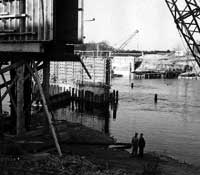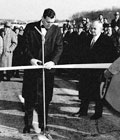 Plans to construct a 66-mile extension of the Maine Turnpike to the state capitol in Augusta, including a four-mile spur to US Route 1 in Falmouth, began very soon after the first section opened. A recommendation from the Maine Good Roads Association in 1949 spurred the State Highway Commission to study the feasibility and potential impact of a Turnpike extension. In April of 1953, the Turnpike Authority issued $75 million in revenue bonds — $55 million to be used for construction.
Plans to construct a 66-mile extension of the Maine Turnpike to the state capitol in Augusta, including a four-mile spur to US Route 1 in Falmouth, began very soon after the first section opened. A recommendation from the Maine Good Roads Association in 1949 spurred the State Highway Commission to study the feasibility and potential impact of a Turnpike extension. In April of 1953, the Turnpike Authority issued $75 million in revenue bonds — $55 million to be used for construction.
 The Turnpike extension was, at the time, the largest highway construction project in Maine history. Two thousand construction workers were employed from the spring of 1954 to the winter of 1955. Twenty million cubic yards of earth, sand and gravel, 145,000 barrels of cement, 350,000 tons of bituminous concrete, 47 million pounds of steel and 11.5 million gallons of asphalt was used to construct the highway extension. Ninety-one bridges were built, including an 846 foot span over the Androscoggin River at Lewiston.
The Turnpike extension was, at the time, the largest highway construction project in Maine history. Two thousand construction workers were employed from the spring of 1954 to the winter of 1955. Twenty million cubic yards of earth, sand and gravel, 145,000 barrels of cement, 350,000 tons of bituminous concrete, 47 million pounds of steel and 11.5 million gallons of asphalt was used to construct the highway extension. Ninety-one bridges were built, including an 846 foot span over the Androscoggin River at Lewiston.
On December 13, 1955, in Augusta, Governor Edmund S. Muskie cut the ribbon opening the Turnpike extension (Section II), eight years to the day the original toll highway opened for business in Portland. In 1956, the Federal Highway Act authorized the construction of the Interstate highway system and precluded the need to further extend the Turnpike.